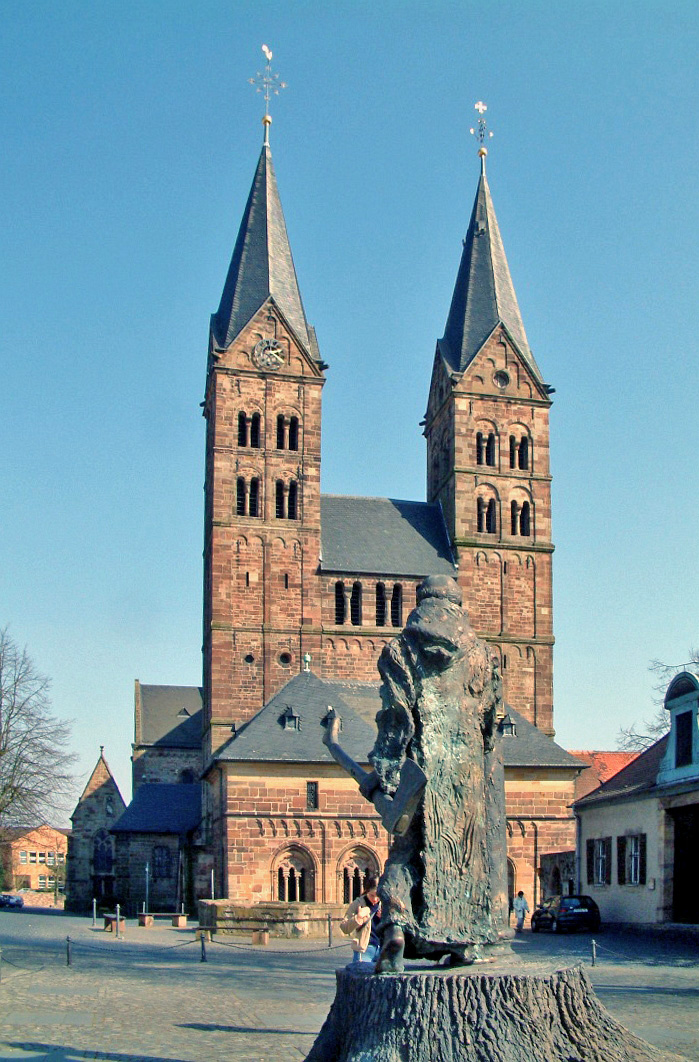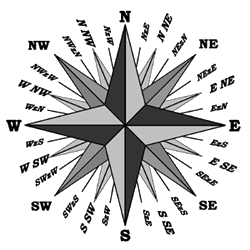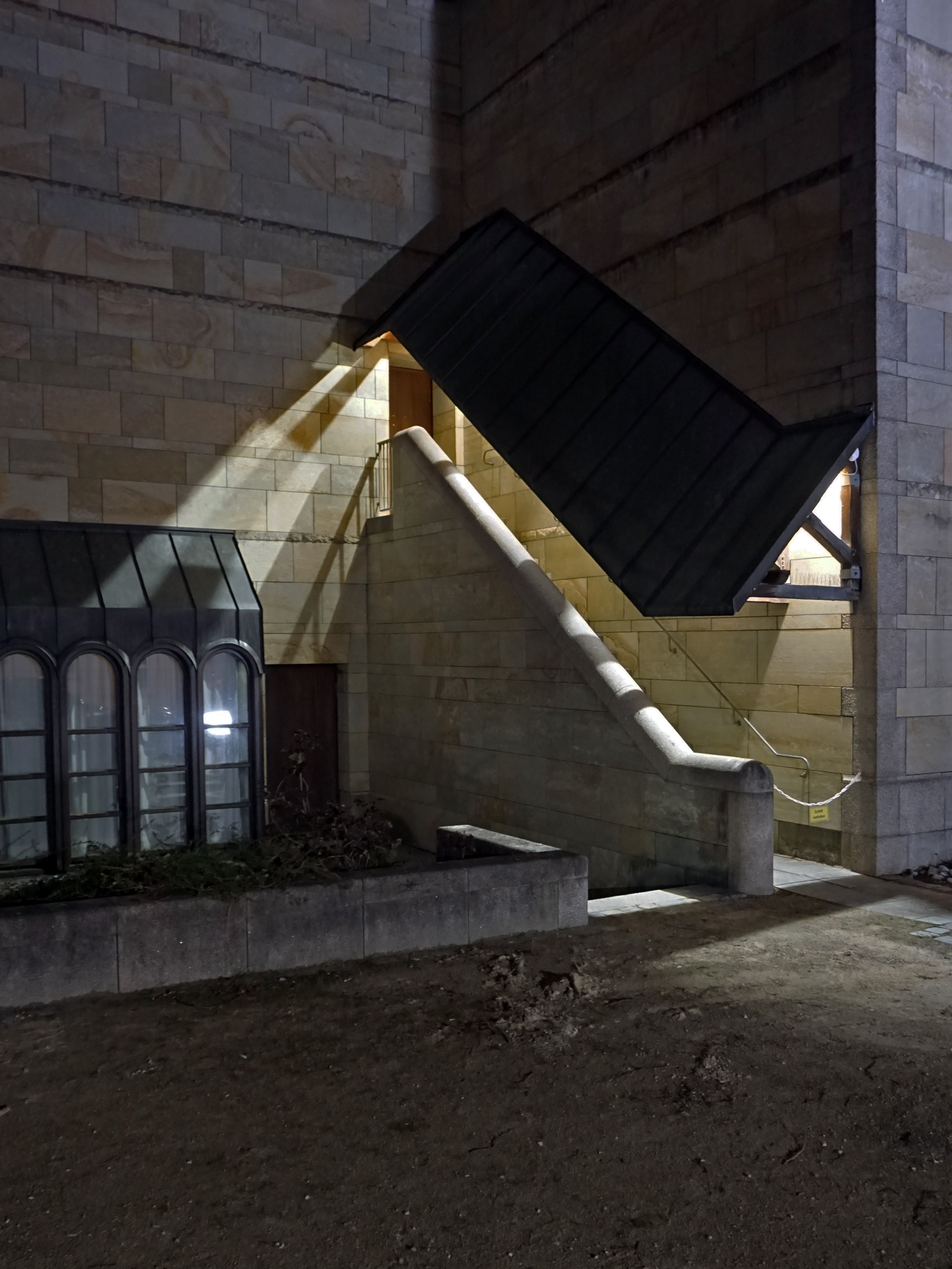|
Stephan Balkenhol
Stephan Balkenhol (born 1957, Fritzlar, Hesse, Germany) is a German artist, famous for his figurative painted wooden sculptures and reliefs. He is currently Professor of Sculpture at the State Academy of Fine Arts Karlsruhe (Germany). Lives and works in Karlsruhe, Germany and Meisenthal, France. Life and career Balkenhol attended the Hamburg School of Fine Arts from 1976 to 1982, and studied under Ulrich Rückriem with Nam June Paik and Sigmar Polke among his tutors. Balkenhol began sculptural wood carving in the mid-1980s. His totem-like sculptures of everyday people continue the European tradition of wooden sculpture and reference folk art and medieval and classical Greek sculpture. As a response to the abstract, minimalist and conceptual approaches of the Hamburg School, Balkenhol decided to concentrate on an everyday persona, instead of an idol or hero. By the 1990s, his repertoire had expanded to include animals and hybrid creatures, as well as architectural motifs and re ... [...More Info...] [...Related Items...] OR: [Wikipedia] [Google] [Baidu] |
Fritzlar
Fritzlar () is a small town (pop. 15,000) in the Schwalm-Eder district in northern Hesse, Germany, north of Frankfurt, with a storied history. The town has a medieval center ringed by a wall with numerous watch towers. Thirty-eight meters (125 ft) high, the "Grey Tower" ("Grauer Turm") is the highest remaining urban defense tower in Germany. The city hall, first documented in 1109, with a stone relief of St. Martin, the town's patron saint, is the oldest in Germany still in use for its original purpose. The Gothic church of the old Franciscan monastery is today the Protestant parish church, and the monastery's other buildings have been converted into a modern hospital. Many houses in the town center, notably around the market square, date from the 15th to 17th centuries and have been carefully maintained or restored. The town is dominated by the imposing Romanesque-Gothic Church of St. Peter from the 12th-14th centuries. In 1974, the town hosted the 14th ''Hessentag'' sta ... [...More Info...] [...Related Items...] OR: [Wikipedia] [Google] [Baidu] |
Lörrach
Lörrach () is a town in southwest Germany, in the valley of the Wiese, close to the French and the Swiss borders. It is the capital of the district of Lörrach in Baden-Württemberg. It is the home of a number of large employers, including the Milka chocolate factory owned by Mondelez International. The city population has grown over the last century, with only 10,794 in 1905, it has now increased its population to 49,382. Nearby is the castle of Rötteln on the Wiesental, whose lords became the counts of Hachberg and a residence of the Margraves of Baden; this was destroyed by the troops of Louis XIV in 1678, but was rebuilt in 1867. Lörrach received market rights in 1403, but it did not obtain the privileges of a city until 1682. After the Napoleonic epoch, the town was included in the Grand Duchy of Baden. On 21 September 1848, Gustav Struve attempted to start a revolutionary uprising in Lörrach as part of the Revolutions of 1848–49. It failed, and Struve was caught a ... [...More Info...] [...Related Items...] OR: [Wikipedia] [Google] [Baidu] |
Neue Pinakothek
The Neue Pinakothek (, ''New Pinacotheca'') is an art museum in Munich, Germany. Its focus is European Art of the 18th and 19th centuries, and it is one of the most important museums of art of the nineteenth century in the world. Together with the Alte Pinakothek and the Pinakothek der Moderne, it is part of Munich's "Kunstareal" (the "art area"). The building The museum was founded by King Ludwig I of Bavaria in 1853. The original building constructed by Friedrich von Gärtner and August von Voit was destroyed during World War II. The ruin of the Neue Pinakothek was demolished in 1949. The building was replaced in the late 20th century. Designed by architect , the new postmodern building opened in 1981. Its features include arched windows, keystones, bay windows and stairways. It combines a concrete construction with a stone facade design. History Ludwig began to collect contemporary art already as crown prince in 1809 and his collection was steadily enlarged. When the mus ... [...More Info...] [...Related Items...] OR: [Wikipedia] [Google] [Baidu] |
National Museum Of Art, Osaka
is a subterranean Japanese art museum located on the island of Nakanoshima, located between the Dōjima River and the Tosabori River, about 10 minutes west of Higobashi Station in central Osaka. The official Japanese title of the museum translates as the "National Museum of International Art". The museum is also known by the English acronym NMAO (National Museum of Art, Osaka). NMAO history Designed by César Pelli & Associates Japan. The museum originates from the Expo Museum of Fine Arts at Expo'70, held in Suita in the outskirts of Osaka. The site was converted into Expo Commemoration Park after the Expo, but the gallery was preserved for possible future use as a permanent art museum. It re-opened in 1977 as the National Museum of Art, as part of the Expo Commemoration Park. Due to the aging of the building as well as growing space limitations, the museum was temporarily closed in January 2004. The old museum was demolished and turned into a car park, while the exhibits wer ... [...More Info...] [...Related Items...] OR: [Wikipedia] [Google] [Baidu] |
Museum Ludwig
Museum Ludwig, located in Cologne, Germany, houses a collection of modern art. It includes works from Pop Art, Abstract and Surrealism, and has one of the largest Picasso collections in Europe. It holds many works by Andy Warhol and Roy Lichtenstein. History The museum emerged in 1976 as an independent institution from the Wallraf-Richartz Museum. That year the chocolate magnate Peter Ludwig agreed to endow 350 modern artworks—then valued at $45 million —and in return the City of Cologne committed itself to build a dedicated "Museum Ludwig" for works made after the year 1900. The recent building, which was designed by architects Peter Busmann and Godfrid Haberer opened in 1986 near the Cologne Cathedral. The new building first became home to both the Wallraf Richartz Museum as well as Museum Ludwig. In 1994, it was decided to separate the two institutions and to place the building on Bischofsgartenstrasse at the sole disposal of Museum Ludwig. In 1999 Steve Keene paint ... [...More Info...] [...Related Items...] OR: [Wikipedia] [Google] [Baidu] |
Los Angeles County Museum Of Art
The Los Angeles County Museum of Art (LACMA) is an art museum located on Wilshire Boulevard in the Miracle Mile, Los Angeles, California, Miracle Mile vicinity of Los Angeles. LACMA is on Museum Row, adjacent to the La Brea Tar Pits (George C. Page Museum). LACMA was founded in 1961, splitting from the Los Angeles Museum of History, Science and Art. Four years later, it moved to the Wilshire Boulevard complex designed by William Pereira. The museum's wealth and collections grew in the 1980s, and it added several buildings beginning in that decade and continuing in subsequent decades. In 2020, four buildings on the campus were demolished to make way for a reconstructed facility designed by Peter Zumthor. His design drew strong community opposition and was lambasted by architectural critics and museum curators, who objected to its reduced gallery space, poor design, and exorbitant costs. LACMA is the list of largest art museums, largest art museum in the western United States. It a ... [...More Info...] [...Related Items...] OR: [Wikipedia] [Google] [Baidu] |
Kunstmuseum Bonn
The Kunstmuseum Bonn or Bonn Museum of Modern Art is an art museum in Bonn, Germany, founded in 1947. The Kunstmuseum exhibits both temporary exhibitions and its collection. Its collection is focused on Rhenish Expressionism and post-war German art. It is part of Bonn's "Museum Mile". Architecture The present building, which opened in 1992, was created by the BJSS firm (Axel Schultes) and Jürgen Pleuser at a cost of about DM-100 million. It has three entrances, symbolising openness. The design of the staircase has been described as a ''"precise geometry, cut like jewellery. The conception of light brings the collection to life."'' The total exhibition area is around . Rhenish Expressionism and art since 1945 The collections of the Kunstmuseum focus on three strong points: Rhenish Expressionism (the largest collection in the world), post-war German art (particularly the 1960s to the early 1990s), and an international collection of post-war prints. German artists on display ... [...More Info...] [...Related Items...] OR: [Wikipedia] [Google] [Baidu] |
Hirshhorn Museum And Sculpture Garden
The Hirshhorn Museum and Sculpture Garden is an art museum beside the National Mall, in Washington, D.C., the United States. The museum was initially endowed during the 1960s with the permanent art collection of Joseph H. Hirshhorn. It was designed by architect Gordon Bunshaft and is part of the Smithsonian Institution. It was conceived as the United States' museum of contemporary and modern art and currently focuses its collection-building and exhibition-planning mainly on the post–World War II period, with particular emphasis on art made during the last 50 years. The Hirshhorn is situated halfway between the Washington Monument and the US Capitol, anchoring the southernmost end of the so-called L'Enfant axis (perpendicular to the Mall's green carpet). The National Archives/National Gallery of Art Sculpture Garden across the Mall, and the National Portrait Gallery/Smithsonian American Art building several blocks to the north, also mark this pivotal axis, a key element of bo ... [...More Info...] [...Related Items...] OR: [Wikipedia] [Google] [Baidu] |
Hamburger Bahnhof
Hamburger Bahnhof is the former terminus of the Berlin–Hamburg Railway in Berlin, Germany, on Invalidenstrasse in the Moabit district opposite the Charité hospital. Today it serves as a contemporary art museum, the , part of the Berlin National Gallery. Original use as a railway station The station was built to Friedrich Neuhaus's plans in 1846/47 as the starting point of the Berlin–Hamburg Railway. It is the only surviving terminus building in Berlin from the late neoclassical period and one of the oldest station buildings in Germany. The building has not been used as a station since 1884, when northbound long-distance trains from Berlin began leaving from Lehrter Bahnhof (now Berlin Hauptbahnhof), just 400 m to the southwest. The original train shed was removed during the 1880s, when the building became an office and apartment complex. Use as a railway museum On 14 December 1906, the former station became home to the new ''Royal Museum of Building and Transport'' ( ... [...More Info...] [...Related Items...] OR: [Wikipedia] [Google] [Baidu] |
Art Institute Of Chicago
The Art Institute of Chicago in Chicago's Grant Park, founded in 1879, is one of the oldest and largest art museums in the world. Recognized for its curatorial efforts and popularity among visitors, the museum hosts approximately 1.5 million people annually. Its collection, stewarded by 11 curatorial departments, is encyclopedic, and includes iconic works such as Georges Seurat's ''A Sunday on La Grande Jatte'', Pablo Picasso's ''The Old Guitarist'', Edward Hopper's '' Nighthawks'', and Grant Wood's '' American Gothic''. Its permanent collection of nearly 300,000 works of art is augmented by more than 30 special exhibitions mounted yearly that illuminate aspects of the collection and present cutting-edge curatorial and scientific research. As a research institution, the Art Institute also has a conservation and conservation science department, five conservation laboratories, and one of the largest art history and architecture libraries in the country—the Ryerson and B ... [...More Info...] [...Related Items...] OR: [Wikipedia] [Google] [Baidu] |
Karl Schmidt-Rottluff
Karl Schmidt-Rottluff (Karl Schmidt until 1905; 1 December 1884 – 10 August 1976) was a German expressionist painter and printmaker; he was one of the four founders of the artist group Die Brücke. Life and work Schmidt-Rottluff was born in Rottluff, nowadays a district of Chemnitz, on 1 December 1884. He attended the ''humanistische gymnasium'' (classics-oriented secondary school) in Chemnitz, where he befriended Erich Heckel. He enrolled in architecture at the Sächsische Technische Hochschule in Dresden in 1905, following in Heckel's footsteps, but gave up after one term. Whilst he was there, however, Erich Heckel introduced him to Ernst Ludwig Kirchner and Fritz Bleyl. They all passionately shared similar artistic interests and used architecture as a front to study art. They founded Die Brücke in Dresden on 7 June 1905, with the aim of creating a style that was uncompromising and which renounced all traditions. Its first exhibition opened in Leipzig in November of the s ... [...More Info...] [...Related Items...] OR: [Wikipedia] [Google] [Baidu] |
Ordre Des Arts Et Des Lettres
The ''Ordre des Arts et des Lettres'' (Order of Arts and Letters) is an order of France established on 2 May 1957 by the Minister of Culture. Its supplementary status to the was confirmed by President Charles de Gaulle in 1963. Its purpose is the recognition of significant contributions to the arts, literature, or the propagation of these fields. Its origin is attributed to the Order of Saint Michael (established 1 August 1469), as acknowledged by French government sources. Background To be considered for the award, French government guidelines stipulate that citizens of France must be at least thirty years old, respect French civil law, and must have "significantly contributed to the enrichment of the French cultural inheritance". Membership is not, however, limited to French nationals; recipients include numerous foreign luminaries. Foreign recipients are admitted into the Order "without condition of age". The Order has three grades: * (Commander) — medallion worn on a ... [...More Info...] [...Related Items...] OR: [Wikipedia] [Google] [Baidu] |








